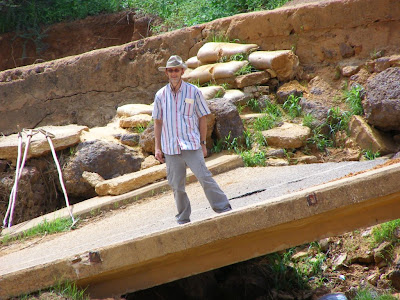
Isn't this a pretty picture? Some beautiful flowers floating on the edge of the Niger River at the ferry crossing. Actually these are dangerous weeds. They're called water hyacinths, and they're choking up rivers and lakes all over Africa, killing fish and the organisms they feed on. It's kind of like kudzu in the southern U.S. In some places, there is a mat of hyacinths several miles long extending from the shore out onto the surface of a lake. The fishermen have to struggle to paddle their boats to get to open water where the fish live. The mat of weeds gets bigger and bigger, and the amount of open water shrinks. It is difficult to get rid of this weed. Poisons don't kill it, and it harms the fish and the people who drink the water and eat the fish. It has no natural enemies that eat it, either. Recently, I read about a microorganism that feeds on the hyacinth. It gradually eats away at the roots little by little, killing one plant at a time. It was the only known method of getting rid of the flower at the time the article was written.

It occurred to me that maybe my life is a bit clogged up with clutter that is choking up my life. It's not so much sin (although every one of us has his or her besetting sins). It's just that I've got so many little details to manage that I can hardly think any more. My life is terribly complicated and full of lots of irreconcileable differences. I'm being pulled into Niamey for different meetings when my main ministry is supposed to be in Tera. I'm supposed to be working in the Songhai language with Songhai people, but I'm actually working mainly with other people groups using the Songhai and French languages. I have some priorities I want to work on this term in Niger: finishing up translation work and publishing it, launching the church in Doumba to be on its own, setting up a good language and culture learning program for Niger, and trying to get repairs to the sports field in Tera moving. But I have gifts that are barely getting used, and I'm getting a little frustrated by that. I'm wearing a lot of hats, and I'm being pulled in many directions. It's hard to concentrate on all these things and do them well. Then there's all the interruptions from people at my door. People are more important, but I also have to get some work done.
I need to simplify, but how? I can't set loose a lot of bugs to finish all the work. And I can't wave a wand and magically get everything accomplished. Little by little some things are moving forward, but it seems as slow as the desert tortoise. Maybe I need to stop and admire the "roses" God has created for a moment, even if they are destructive. These water hyacinths are prominent every year at this time on the Niger River. So far they haven't choked up the river, but they are sometimes a problem for the canoes. I don't want my life so choked up that I'm paralyzed. But I do want to have time for beauty and laughter. Let's look at the "roses."





